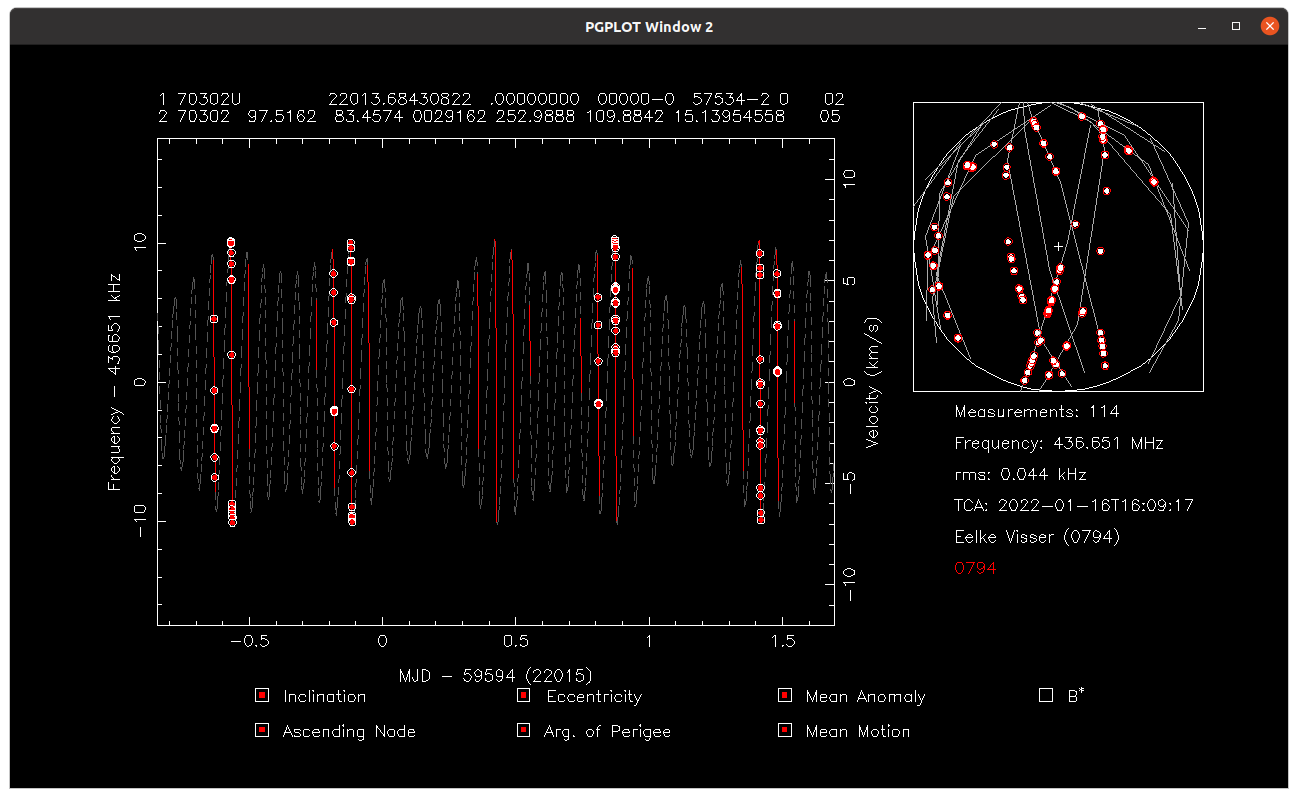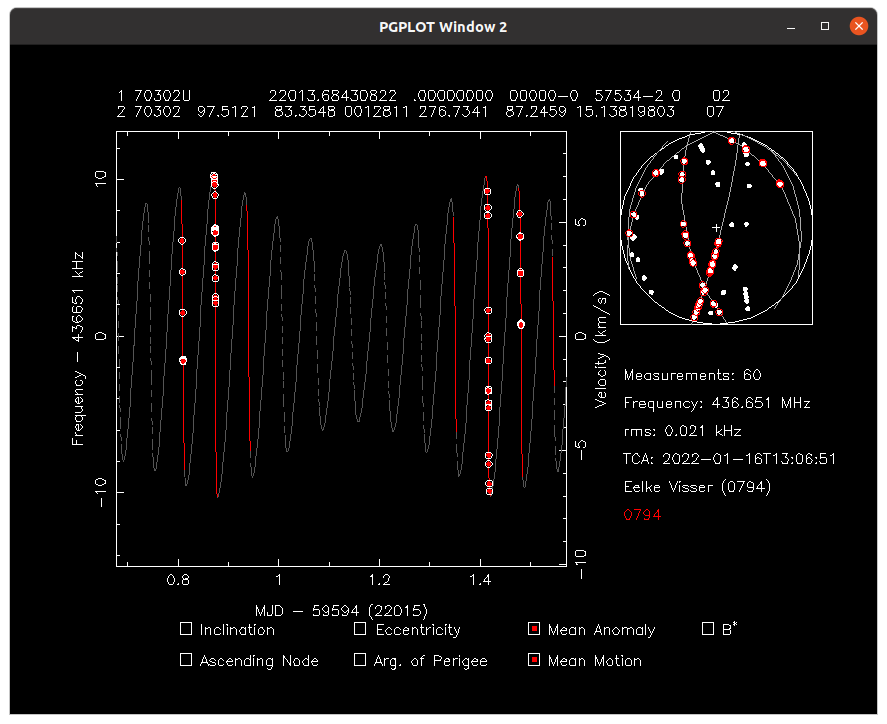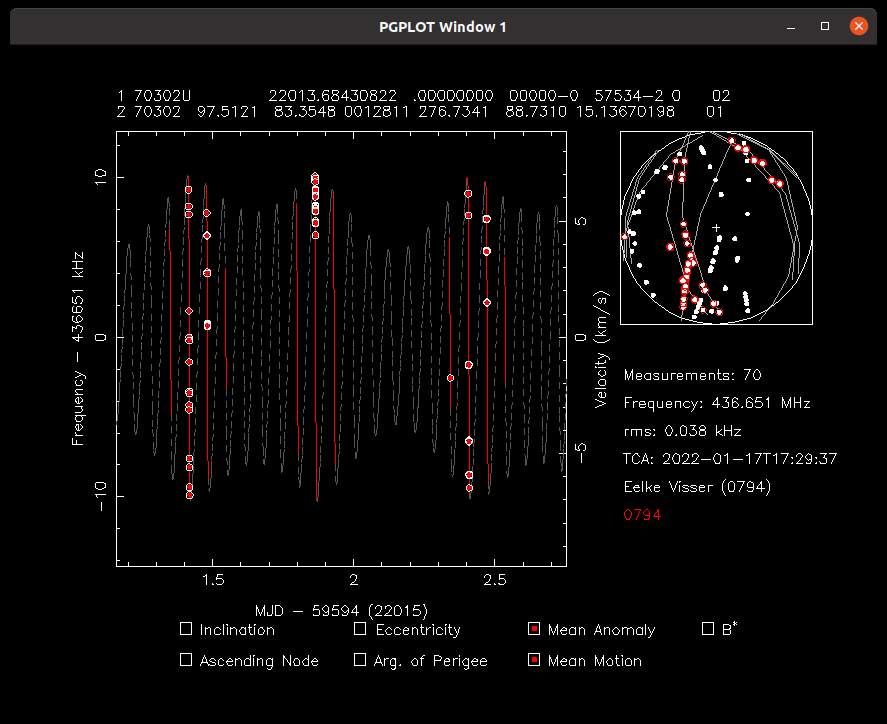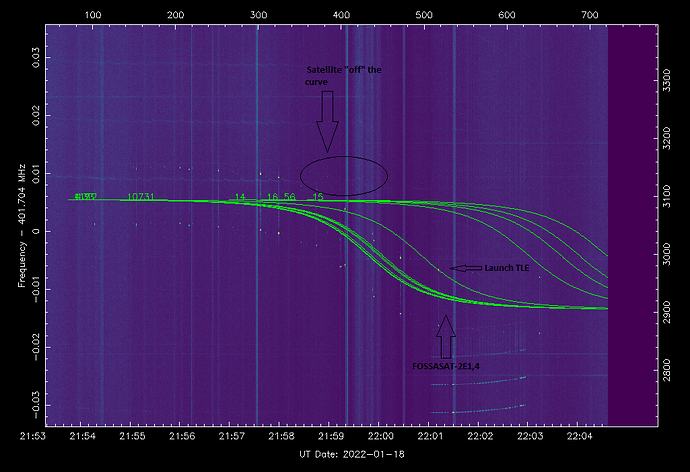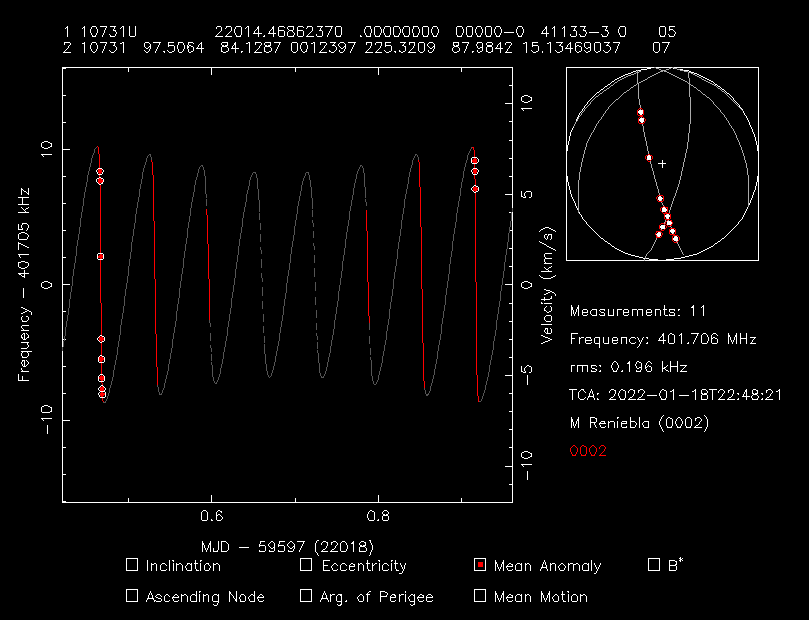Dont forget, the 401-405 MHz use intensively by the meteo sondes, especially in the standard balloon launch time at 00:0 and 12:00 hours.
You can check the your near balloons here:
I have updated the tle of Delfi-PQ, with another 4 passes. I needed to fit all parameters, to get the residual down.
This gives tle:
1 70302U 22013.68430822 .00000000 00000-0 57534-2 0 02
2 70302 97.5162 83.4574 0029162 252.9888 109.8842 15.13954558 05
# 20220114.37-20220116.48, 114 measurements, 0.044 kHz rms
I hope this tle is accurate for a while.
Maybe not so good idea to try to fit all the parameters. Over such a long arc the transmit frequency might have change slightly, masking as changes in the parameters in this fit. How much did each parameter change with the fit? Perhaps a better idea is to use only the last 2 days of data or so, and only fit mean anomaly and perhaps mean motion.
A new TLE set for Grizu-263A by the team, it is not fully accurate but it is better than the post-launch one of Celestrak:
Grizu-263A
1 99488U 22016.68476757 .00002666 00000-0 15017-3 0 00009
2 99488 097.5247 086.3225 0014213 222.2122 274.4592 15.13208794000478
That is also possible, and gives indeed a low residual.
1 70302U 22013.68430822 .00000000 00000-0 57534-2 0 02
2 70302 97.5121 83.3548 0012811 276.7341 87.2459 15.13819803 07
# 20220115.81-20220116.48, 60 measurements, 0.021 kHz rms
I do not have enough experience to say which tle will hold up better in the future.
The TLE set for Delfi-PQ above, with using the temporary NORAD ID and propagated to today:
Delfi-PQ
1 99489U 22016.00000000 .00000000 00000-0 57534-2 0 09
2 99489 97.5121 85.6393 0012811 246.2946 131.6449 15.14316081 04
Hello,
SATLLA-2A and SATLLA-2B nano-satellites are both using LoRa protocol only. However, a new protocol was added to their webpage which is wrong.
For any question/issue please contact the SATLLA team at kcg(at)g.ariel.ac.il.
Regards
Thanks for letting us know, it seems that the satellite that was visible in SATLLA-2B was CSIM satellite.
I guess they won’t be receiving any support from SatNOGS then!
How about using a non-closed protocol next time. LoRa does not belong in the amateur radio band.
@calvin There are some observations on 2022-01-15 with an unknown signal that maybe is PION-BR1. Can you take a look and let us know? It seems to follow the 1min interval and it is close to the frequency. Here is the link with the observations:
https://network.satnogs.org/observations/?future=0&good=1&bad=0&unknown=0&failed=0&norad=99480
Do you manage to receive anything?
Unfortunately this is ASTROCAST 0.1 transmitting 150KHz off from its coordinated frequency. Thanks @EelkeVisser for his help finding this.
Thanks. We understand that. We plan to use a non-closed protocol the next sat. Nevertheless, we use tinyGS as a platform to receive messages. Thank you.
Updated the previous tle of Delfi-PQ:
I decided to use 3 groups of passes, because the center group only had a few points. Only the MA and MM have been updated to:
1 70302U 22013.68430822 .00000000 00000-0 57534-2 0 02
2 70302 97.5121 83.3548 0012811 276.7341 88.7310 15.13670198 01
# 20220116.41-20220117.47, 70 measurements, 0.038 kHz rms
Great! Checked with ikhnos, added in DB (with the temporary NORAD ID and propagated appropriatelly) and in Network.
Delfi-PQ
1 99489U 22017.00000000 .00000000 00000-0 57534-2 0 00
2 99489 97.5121 86.6257 0013153 267.1380 158.9125 15.14361907 08
Here is an updated TLE for SanoSat-1 from @orionspacenepal on Twitter w/ the Object #, spacing & checksums corrected:
SanoSat-1
1 99499U 22017.58440691 +.00009097 +00000+0 +50832-3 0 18
2 99499 97.5061 87.2015 0014119 212.3800 147.6567 15.13643403000 67
The .5k GFSK downlink from SanoSat-1 is alive! Congrats to the Project Team from Nepal.
The latest TLE we use for the GRIZU-263 is as follows :
GRIZU-263A
1 99488U 22016.68476757 .00002652 00000-0 15013-3 0 00000
2 99488 097.5247 086.3217 0013698 224.6598 270.0848 15.13030006000473
This fits better than the current
@EA4GPZ I cannot decode GRIZU-263A using gr_satellites 
Maybe an update needed for these parameters;
- manchester coding is enabled which has been set by thje following command
setEncoding(RADIOLIB_ENCODING_MANCHESTER);
- CRC is IBM CRC that has been set by the following parameters
setCRC(2, 0xFFFF, 0x8005, false)
Does the decoder module for gr_satellites need an update to be able to decode ?
Thanks
Baris Dinc
OH2UDS/TA7W
The first Satnogs passes with clear indication of what resembles FOSSA Satellites, The TLE seems to be way off though. SatNOGS Network - Observation 5315277 SatNOGS Network - Observation 5318157
I can see clear +/-5KHz 9k6 beacons but the 3º elevation and erroneous doppler correction seems off.
Unfortunately we haven’t been able to decode yet to confirm it’s a FOSSASAT-2E
Here are the latest TLE’s from LEOLABS, we can confirm FOSSASAT-2E1 is probably FOSSAT_A and FOSSASAT-2E4 is probably FOSSAT_C
0 LL_FOSSAT_A
1 70303U 12345AAA 22016.45276447 .00096032 00000-0 54126-2 0 01
2 70303 97.5255 86.0940 0014119 224.6634 92.3626 15.13689557000006
1 LL_FOSSAT_B
1 70303U 12345AAA 22016.45278051 .00096032 00000-0 54126-2 0 04
2 70303 97.5255 86.0940 0014119 224.6633 92.3704 15.13591276000002
0 LL_FOSSAT_C
1 70303U 12345AAA 22016.45281316 .00096032 00000-0 54126-2 0 02
2 70303 97.5255 86.0940 0014119 224.6631 92.3568 15.13690829000002
0 LL_FOSSAT_D
1 00000U 12345AAA 22016.45360047 .00000000 +00000-0 47191-3 0 03
2 00000 97.5086 86.0854 0012375 223.2685 93.7193 15.13037253000006
0 LL_FOSSAT_E
1 00000U 12345AAA 22016.45383521 .00000000 +00000-0 60760-3 0 02
2 00000 97.5091 86.0875 0011409 231.5498 85.4261 15.12498583000006
0 LL_FOSSAT_F
1 00000U 12345AAA 22016.45386308 .00000000 +00000-0 60760-3 0 08
2 00000 97.5091 86.0875 0011409 231.5497 85.4317 15.12911812000002
Here is a recent pass showing a drifting satellite and the confirmed sats.
Here is the drifting satellite based on several passes.
RE: cannot decode GRIZU-263A using gr_satellites
Can you share an audio example so I can check the decoder and maybe also see what these updates will produce?
The following input can be read by gr_satellites:
-wavfile WAVFILE | --rawfile RAWFILE | --rawint16 RAWINT16 | --audio [DEVICE]
Please also share the sample rate.
